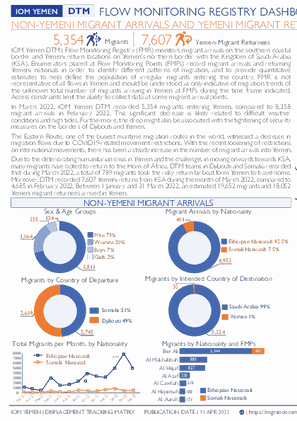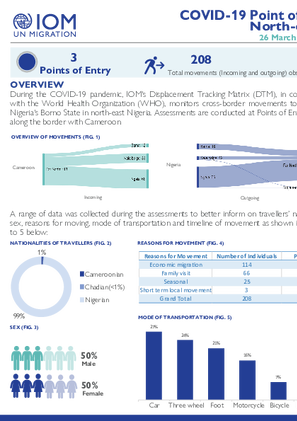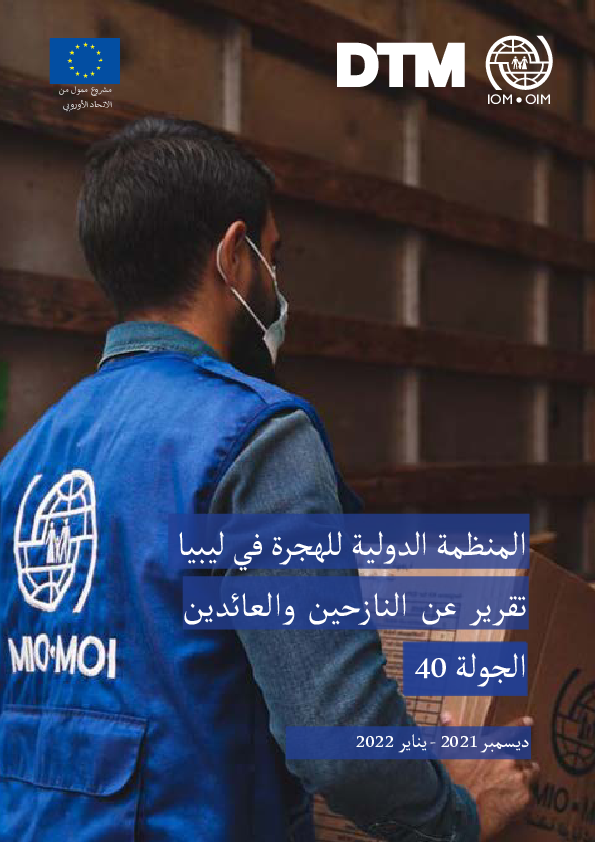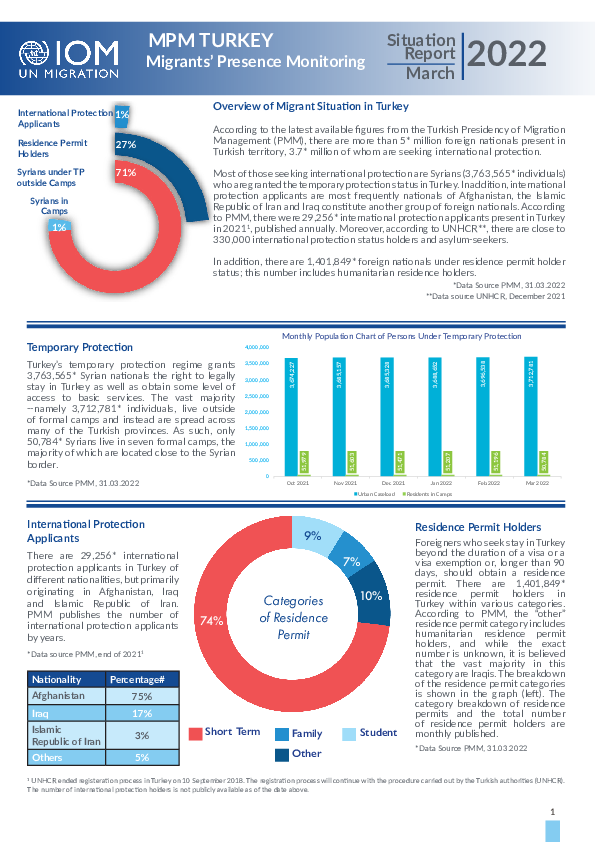-
Countries
-
Data and Analysis
-
Special Focus
-
Crisis Responses

Contact
DTM Yemen, iomyemendtm@iom.int
Language
English
Location
Yemen
Period Covered
Mar 01 2022
Mar 31 2022
Activity
- Flow Monitoring Survey
- Flow Monitoring
- Mobility Tracking
In March 2022, IOM Yemen DTM recorded 5,354 migrants entering Yemen, compared to 8,358 migrant arrivals in February 2022. This significant decrease is likely related to difficult weather conditions and high tides. Furthermore, the drop might also be associated with the tightening of security measures on the borders of Djibouti and Yemen.
The Eastern Route, one of the busiest maritime migration routes in the world, witnessed a decrease in migration flows due to COVID19-related movement restrictions. With the recent loosening of restrictions on international movements, there has been a steady increase in the number of migrant arrivals into Yemen.
Due to the deteriorating humanitarian crisis in Yemen and the challenges in moving onwards towards KSA, many migrants have opted to return to the Horn of Africa. DTM teams in Djibouti recorded that during March 2022, a total of 789 migrants took the risky return by boat form Yemen to travel home. Moreover, DTM recorded 7,607 Yemeni returns from KSA during the month of March 2022, compared to 4,685 in February 2022. Between 1 January and 31 March 2022, an estimated 19,652 migrants and 18,052 Yemeni migrant returnees arrived in Yemen.
The migrant caseload was around 93 per cent Ethiopian nationals, and around eight per cent Somali nationals. The migrants are predominantly male (71%), with (20%) women, seven per cent boys and two per cent girls also among the travelers.
Through March’s reporting period, 2,745 migrants arrived from Somalia and were recorded at Ber Ali flow monitoring point in Shabwah governorate. In Lahj governorate, 2,609 migrants arrived from Djibouti, wherein 885 were recorded at Al Makhabah flow monitoring point (FMP), 827 at Al Hejaf FMP, 330 at Al Azaf FMP, 216 at Al Cawhah FMP, 180 at Al Hajeimah FMP, and 171 at Al Aarah FMP.

Contact
DTM CAR, DTMRCA@iom.int
Language
French
Location
Central African Republic
Period Covered
Apr 01 2022
Apr 04 2022
Activity
- Event Tracking
- Rapid Emergency Registration
Le suivi des situations d’urgence (en anglais, Emergency Tracking Tool, ETT) est une des composantes de la Matrice
de suivi des déplacements (DTM) déployée par l’Organisation Internationale pour les Migrations (OIM). Il a pour
objectif de recueillir des informations relatives aux déplacements causés par une crise ou des évènements soudains. Il
offre une évaluation préliminaire d’une situation pouvant informer des évaluations plus approfondies et permettant
de rapidement mettre en oeuvre des mécanismes de réponse. Les informations sont collectées auprès d’informateurs
clés (représentants de déplacés, leaders communautaires) au moyen d’un questionnaire structuré axé sur les
déplacements et les besoins humanitaires multisectoriels. Un formulaire d’enregistrement rapide a été également
déployé auprès des ménages pour établir leur profil démographique (recensement par sexe et catégorie d’âge et
identification des vulnérabilités présentes). Ce tableau de bord donne un aperçu de l’évaluation rapide réalisée entre
Du 1er au 3 Avril 2022 dans la ville de Ndele suite à l’arrivée de nouveaux déplacés internes ayant été contraints de
fuir des villages subissant des attaques armées dans la commune de Darel kouti (Bamingui Bangoran) ainsi que dans la
préfecture de Vakaga (village de Nda).

Contact
DTM Nigeria, AllUsersInDTMNigeria@iom.int
Language
English
Location
Nigeria
Period Covered
Mar 01 2022
Mar 31 2022
Activity
- Mobility Tracking
- Baseline Assessment
- Points of Entry (PoE)
During the COVID-19 pandemic, IOM's Displacement Tracking Matrix (DTM), in collaboration with the World Health Organization (WHO), monitors cross-border movements to and from Nigeria's Borno State in north-east Nigeria. Assessments are conducted at Points of Entry located along the border with Cameroon.
A range of data was collected during the assessments to better inform on travellers’ nationalities, sex, reasons for moving, mode of transportation and timeline of movement as shown in figures 2 to 5 below.

Contact
DTM Nigeria, AllUsersInDTMNigeria@iom.int
Language
English
Location
Nigeria
Period Covered
Mar 26 2022
Apr 01 2022
Activity
- Mobility Tracking
- Baseline Assessment
- Points of Entry (PoE)
During the COVID-19 pandemic, IOM's Displacement Tracking Matrix (DTM), in collaboration with the World Health Organization (WHO), monitors cross-border movements to and from Nigeria's Borno State in north-east Nigeria. Assessments are conducted at Points of Entry located along the border with Cameroon.
A range of data was collected during the assessments to better inform on travellers’ nationalities, sex, reasons for moving, mode of transportation and timeline of movement as shown in figures 2 to 5 below

Contact
DTM Nigeria, AllUsersInDTMNigeria@iom.int
Language
English
Location
Nigeria
Period Covered
Mar 28 2022
Apr 03 2022
Activity
- Event Tracking
- Mobility Tracking
Nigeria's north-central and north-west zones are afflicted with a multidimensional crisis rooted in long-standing tensions between ethnic and religious groups and involves attacks by criminal groups and banditry/hirabah (such as kidnapping and grand larceny along major highways). During the past years, the crisis has accelerated because of the intensification of attacks and has resulted in widespread displacement across the region.
Between the 28th March and 3rd of April 2022, armed clashes and banditry have led to new waves of population displacement. Following these events, rapid assessments were conducted by DTM (Displacement Tracking Matrix) field staff to inform the humanitarian community and government partners, and enable targeted response. Flash reports utilise direct observation and a broad network of key informants to gather representative data and collect information on the number, profile and immediate needs of affected populations.
During the assessment period, the DTM identified an estimated 8,812 individuals who were affected by the attacks. In Chikun LGA, a train coming from Abuja and heading towards Kaduna was attacked on 28 March 2022. The attack affected 923 individuals on board, with 23 injuries and 11 casualties. Additionally, a total of 7,828 individuals were displaced to neighbouring wards in the LGAs Giwa, Kachia and Kagarko in Kaduna State, Sabuwa in Katsina State, Bassa in Plateau State, Rabah and Wurno in Sokoto State and Talata Mafara in Zamfara State. A total of 161 casualties were reported, including 100 injuries and 61 fatalities.

Contact
DTM Libya, DTMLibya@iom.int
Language
Arabic
Location
Libya
Period Covered
Dec 01 2021
Jan 31 2022
Activity
- Mobility Tracking
- Baseline Assessment
يعرض تقرير مصفوفة تتبع النزوح الخاصّة بالمنظمة الدولية للهجرة البيانات والمستخلصات حول النازحين داخليا والعائدين فيما بين شهري ديسمبر من سنة 2021 وشهر يناير من سنة 2022 وفي إطار الجولة 40 من تتبع التنقل في ليبيا. وتماشيا مع التوجّه الذي امتدّ طيلة سنة 2021، تواصل انخفاض عدد النازحين داخليا في البلاد وتزامن ذلك مع ارتفاع في عدد العائدين، إذ بلغ عددهم في الجولة الـ40 673.553 فردا في مقارنة بعدد 661.892 عائدا تم إحصاؤهم في الجولة 39. ويشير ذلك إلى ارتفاع طفيف (بنسبة 2 في المائة)في عدد الأفراد العائدين إلى مناطق أصلهم وإلى ارتفاع بنسبة 19 في المائة عن شهر أكتوبر 2020 الذي شهد وقف إطلاق النار في ليبيا. وقد تواصل انخفاض عدد النازحين في هذه الجولة نتيجة لاستمرار توجّه العودة إلى مناطق الأصل من 179.047 نازحا في شهر نوفمبر من سنة 2021 إلى 168.011 نازحاً مع نهاية شهر يناير من سنة 2022. ويمثّل هذا انخفاضاً بنسبة 47 في المائة في عدد الأفراد النازحين داخليا في ليبيا منذ وقف إطلاق النار في شهر أكتوبر من سنة 2020 (عندما تم إحصاء 316.415 نازحاً).

Contact
DTM Turkey, DTMTurkey@iom.int
Language
English
Location
Republic of Türkiye
Period Covered
Mar 01 2022
Mar 31 2022
Activity
- Flow Monitoring Survey
- Flow Monitoring
According to the latest available figures from the Turkish Presidency of Migration Management (PMM), there are more than 5* million foreign nationals present in Turkish territory, 3.7* million of whom are seeking international protection. Most are Syrians (3,763,565* individuals) who are granted temporary protection status. In addition, international protection applicants from countries including Afghanistan, the Islamic Republic of Iran and Iraq constitute another group of foreign nationals. According to
PMM, there were 29,256* international protection applicants present in Turkey in 20211, published annually. Moreover, according to UNHCR**, there are close to 330,000 international protection status holders and asylum-seekers. The number of foreign nationals has increased by 95,541 in comparison to March 2021 (3.6 million foreign nationals).
In addition, there are 1,401,849* foreign nationals present in Turkey holding residency permits, including humanitarian residency holders. Compared to March 2021, this is an increase of 356,504 individuals. The exact number of humanitarian residency holders is unknown, but it is estimated that there are more than several thousand humanitarian residency permit holders.
*Data source PMM, 31.03.2022
**Data source UNHCR, December 2021

Contact
DTM Turkey, dtmturkey@iom.int
Language
English
Location
Republic of Türkiye
Period Covered
Mar 01 2022
Mar 31 2022
Activity
- Flow Monitoring Survey
- Flow Monitoring
- Migrants presence
According to the latest available figures from the Turkish Presidency of Migration Management (PMM), there are more than 5* million foreign nationals present in Turkish territory, 3.7* million of whom are seeking international protection.
Most of those seeking international protection are Syrians (3,763,565* individuals) who are granted the temporary protection status in Turkey. In addition, international protection applicants are most frequently nationals of Afghanistan, the Islamic Republic of Iran and Iraq constitute another group of foreign nationals. According to PMM, there were 29,256* international protection applicants present in Turkey in 20211, published annually. Moreover, according to UNHCR**, there are close to 330,000 international protection status holders and asylum-seekers.
In addition, there are 1,401,849* foreign nationals under residence permit holder status; this number includes humanitarian residence holders.
*Data Source PMM, 31.03.2022
**Data source UNHCR, December 2021

Contact
DTM Nigeria, AllUsersInDTMNigeria@iom.int
Language
English
Location
Nigeria
Period Covered
Mar 28 2022
Apr 03 2022
Activity
- Event Tracking
- Mobility Tracking
The DTM Emergency Tracking Tool (ETT) is deployed to track and to collect information on large and sudden population movements, provide frequent updates on the scale of displacement and quantify the affected population when needed. As a sub-component of the Mobility Tracking methodology in Nigeria. ETT utilises direct observation and a broad network of key informants to capture best estimates of the affected population per location, enabling targeted humanitarian response planning.
Between 28 March and 03 April 2022, a total of 2,440 movements were recorded in Adamawa and Borno States. The recorded movements consisted of 2,084 arrivals and 356 departures. Arrivals were recorded at locations in Askira/Uba, Bama, Gwoza, Kala/Balge and Ngala Local Government Areas (LGAs) of the most conflict-affected state of Borno and in Fufore, Gombi, Hong, Lamurde, Maiha, Michika, Mubi North, Mubi South, Song, Yola North and Yola South LGAs of Adamawa State.
Departures were recorded in Askira/Uba and Bama LGAs of Borno State and in Fufore, Gombi, Hong, Maiha, Michika, Mubi North, Numan, Song, Yola North and Yola South LGAs of Adamawa State. ETT assessments identified the following movement triggers: voluntary relocation (1,175 individuals or 48%), military operations (491 individuals or 20%), poor living conditions (399 individuals or 16%), improved security (262 individuals or 11%), fear of attacks (53 individuals or 2%), conflicts/attacks (43 individuals or 2%) and seasonal farming (17 individuals or 1%).
The Horn of Africa and Yemen is one of the busiest and riskiest migration corridors in the world travelled by hundreds of thousands of migrants, the majority of whom travel in an irregular manner, often relying on smugglers to facilitate movement along the Eastern Route. This regional report provides monthly updates on the complex migratory dynamics through Djibouti, Somalia, Yemen and Ethiopia based on diverse data sources and consultations with key informants in the four countries. Moreover, it provides information on the main protection concerns for migrants along the journey, information on the spill over effects of the conflict in Northern Ethiopia observed at the border between Ethiopia, Kenya and Sudan, a specific focus on children and information on the returns from Saudi Arabia to Ethiopia, Somalia and Yemen.

